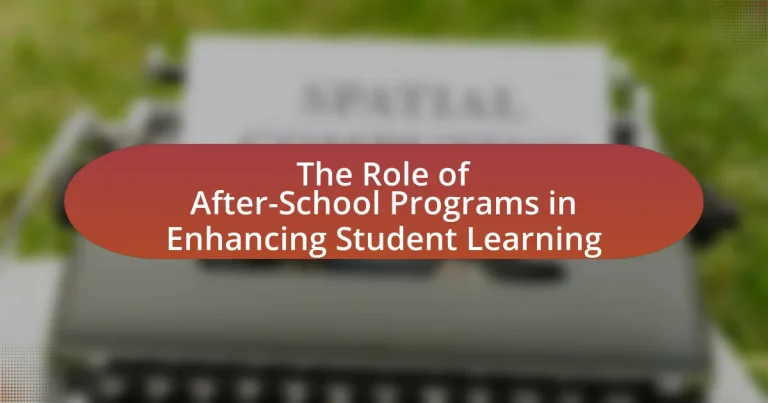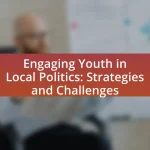After-school programs are structured activities designed to provide students with additional educational opportunities and support beyond regular school hours. These programs aim to enhance academic performance, foster social skills, and create a safe environment for constructive engagement. The article explores the various types of after-school programs, their impact on student learning and development, and the challenges they face, including funding issues and varying program quality. It highlights the importance of these programs, particularly for at-risk students, and discusses best practices for improving their effectiveness through community partnerships and structured curricula.
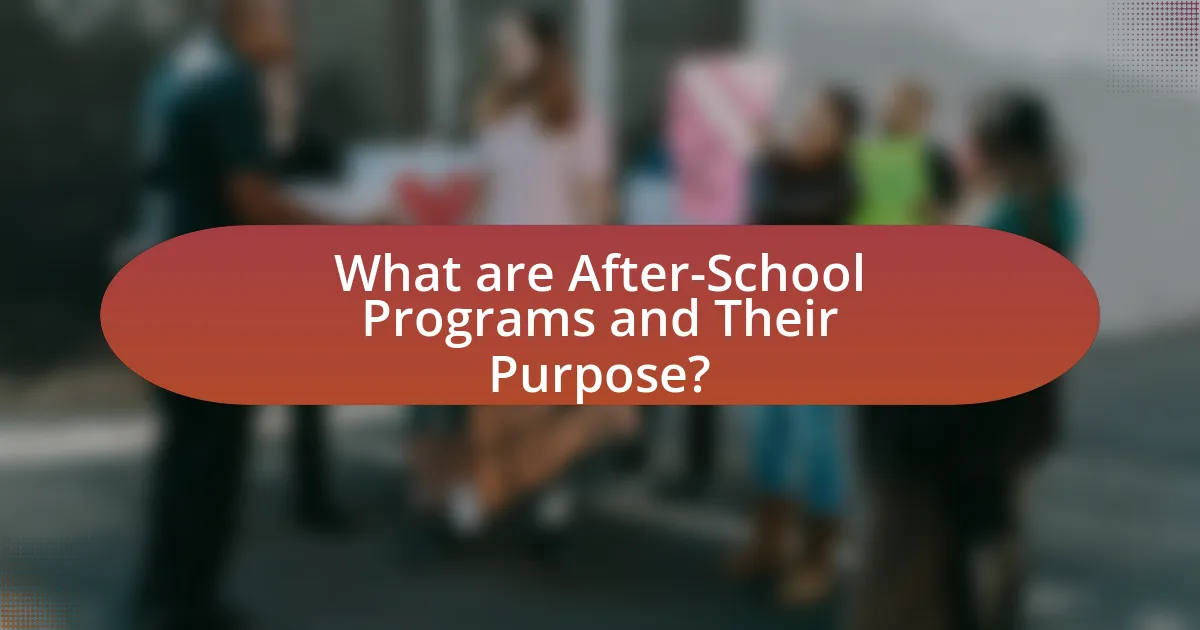
What are After-School Programs and Their Purpose?
After-school programs are structured activities that take place after the traditional school day ends, designed to provide students with additional educational opportunities and support. Their purpose includes enhancing academic performance, fostering social skills, and providing a safe environment for children to engage in constructive activities. Research indicates that participation in after-school programs can lead to improved grades and test scores, as well as increased engagement in school, as evidenced by a study from the Afterschool Alliance, which found that students involved in such programs are more likely to attend school regularly and demonstrate better behavior.
How do After-School Programs differ from regular school hours?
After-school programs differ from regular school hours primarily in their structure and focus. Regular school hours typically emphasize core academic subjects and standardized curricula, while after-school programs often provide enrichment activities, such as arts, sports, and tutoring, that promote holistic development. Research indicates that after-school programs can enhance student learning by offering personalized support and fostering social skills, which are less emphasized during standard school hours. For example, a study by the Afterschool Alliance found that students participating in after-school programs showed improved academic performance and increased engagement in school activities.
What activities are typically included in After-School Programs?
After-school programs typically include a variety of activities such as academic support, arts and crafts, sports, and recreational activities. These programs are designed to provide students with opportunities for homework assistance, skill development, and social interaction. Research indicates that structured after-school activities can enhance student learning by improving academic performance and fostering personal growth. For instance, a study by the Afterschool Alliance found that students participating in after-school programs showed improved grades and attendance compared to their peers who did not participate.
Why are After-School Programs important for student development?
After-school programs are important for student development because they provide structured environments that promote academic achievement, social skills, and emotional well-being. Research indicates that students who participate in after-school programs demonstrate improved grades, better attendance, and increased engagement in school activities. For instance, a study by the Afterschool Alliance found that 74% of students in after-school programs reported improved academic performance. Additionally, these programs foster social interactions, helping students develop teamwork and communication skills, which are essential for their future success.
What types of After-School Programs exist?
After-school programs can be categorized into several types, including academic enrichment programs, arts and culture programs, sports and recreation programs, and mentoring programs. Academic enrichment programs focus on improving students’ skills in subjects like math and reading, often providing tutoring and homework help. Arts and culture programs encourage creativity through activities such as music, dance, and visual arts. Sports and recreation programs promote physical activity and teamwork through organized sports and games. Mentoring programs connect students with adult mentors to provide guidance and support, fostering personal and academic growth. Each type of program plays a significant role in enhancing student learning by addressing diverse interests and needs.
How do academic-focused programs enhance learning?
Academic-focused programs enhance learning by providing structured environments that reinforce educational concepts and skills outside of traditional classroom settings. These programs often include targeted tutoring, enrichment activities, and hands-on projects that align with school curricula, thereby deepening students’ understanding of subjects. Research indicates that students participating in after-school academic programs show improved academic performance, with studies revealing that such programs can lead to a 10-20% increase in standardized test scores. This improvement is attributed to personalized attention from educators and the opportunity for students to engage in collaborative learning experiences, which fosters critical thinking and problem-solving skills.
What role do enrichment programs play in student engagement?
Enrichment programs significantly enhance student engagement by providing diverse learning opportunities that stimulate interest and motivation. These programs often include activities such as arts, sports, and academic clubs, which cater to various student interests and learning styles. Research indicates that students participating in enrichment programs demonstrate higher levels of engagement, as evidenced by a study from the Afterschool Alliance, which found that 74% of students reported increased interest in school due to participation in after-school enrichment activities. This engagement is crucial for academic success, as it fosters a positive learning environment and encourages students to take an active role in their education.
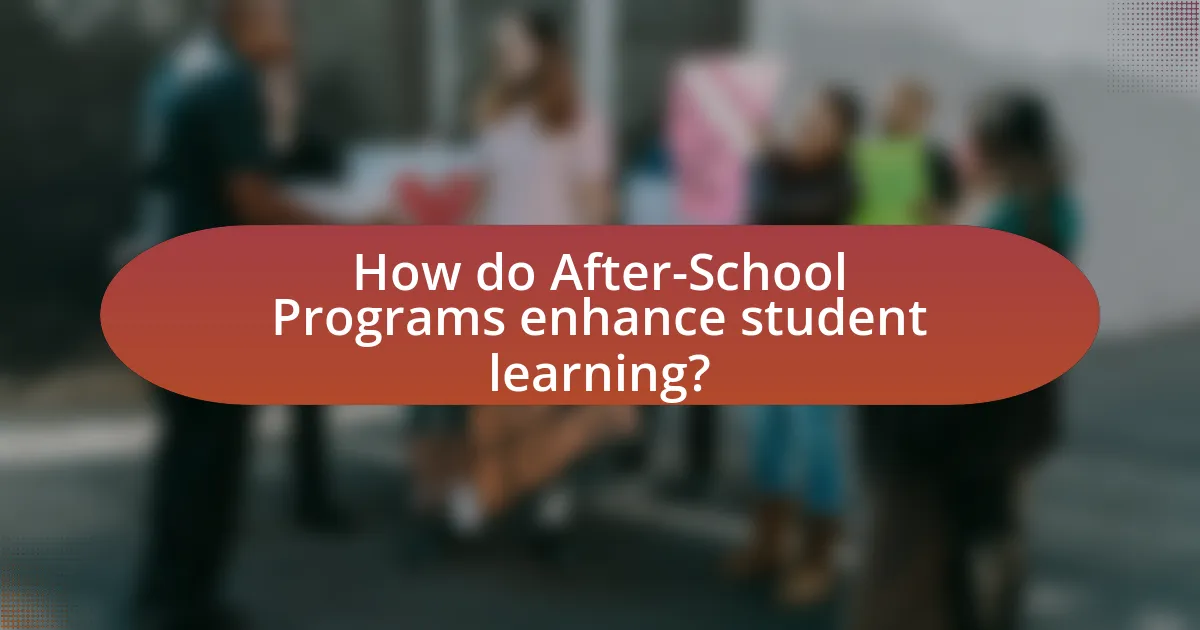
How do After-School Programs enhance student learning?
After-school programs enhance student learning by providing additional academic support and enrichment opportunities outside of regular school hours. These programs often include tutoring, homework assistance, and skill-building activities that reinforce classroom learning. Research indicates that students participating in after-school programs show improved academic performance, with a study by the Afterschool Alliance revealing that 75% of teachers believe these programs help students succeed academically. Furthermore, after-school programs foster social skills and engagement, contributing to a more well-rounded educational experience.
What evidence supports the effectiveness of After-School Programs?
After-school programs have been shown to improve student outcomes significantly. Research indicates that students participating in these programs demonstrate higher academic performance, improved attendance rates, and enhanced social skills. For instance, a study by the Afterschool Alliance found that 74% of teachers reported that after-school programs help students improve their grades, while the Harvard Family Research Project highlighted that students in after-school programs scored better on standardized tests compared to their peers not enrolled in such programs. Additionally, a meta-analysis by Durlak et al. (2011) revealed that after-school programs can lead to an average effect size of 0.21 in academic achievement, indicating a positive impact on learning outcomes.
How do these programs impact academic performance?
After-school programs positively impact academic performance by providing additional support and resources that enhance student learning. Research indicates that students participating in these programs often show improved grades, higher test scores, and increased engagement in school activities. For instance, a study by the Harvard Family Research Project found that students involved in after-school programs had a 20% increase in math and reading scores compared to their peers who did not participate. This improvement is attributed to the structured environment, access to tutoring, and opportunities for hands-on learning experiences that these programs offer.
What social skills do students develop through After-School Programs?
Students develop various social skills through After-School Programs, including teamwork, communication, conflict resolution, and leadership. These programs often involve group activities that require collaboration, allowing students to practice working together towards common goals. For instance, participating in team sports or group projects enhances their ability to communicate effectively and resolve disagreements amicably. Research indicates that students engaged in structured after-school activities show improved social interactions and increased self-esteem, which further supports their social skill development.
Why are After-School Programs crucial for at-risk students?
After-school programs are crucial for at-risk students because they provide a structured environment that fosters academic support, social skills development, and emotional well-being. These programs often offer tutoring and homework assistance, which can lead to improved academic performance; studies show that students participating in after-school programs have higher grades and test scores compared to their peers who do not participate. Additionally, these programs help reduce risky behaviors by keeping students engaged in positive activities during critical after-school hours, which is supported by research from the Afterschool Alliance indicating that such programs can decrease dropout rates and improve school attendance.
How do these programs provide support for underprivileged communities?
After-school programs provide support for underprivileged communities by offering academic assistance, mentorship, and enrichment activities that enhance learning opportunities. These programs often address educational disparities by providing resources such as tutoring in core subjects, which can lead to improved academic performance; for instance, a study by the Afterschool Alliance found that students in after-school programs showed a 20% increase in math and reading scores compared to their peers. Additionally, these programs foster a safe environment for children, allowing them to engage in constructive activities while their parents are at work, thereby reducing the likelihood of involvement in risky behaviors. By connecting students with mentors and role models, after-school programs also help build social skills and self-esteem, which are crucial for personal development and future success.
What specific challenges do at-risk students face that After-School Programs address?
At-risk students face challenges such as academic underachievement, lack of supervision, and social-emotional issues, which After-School Programs specifically address. These programs provide structured academic support, including tutoring and homework assistance, which helps improve grades and comprehension. Additionally, they offer a safe environment that reduces the risk of engaging in negative behaviors during after-school hours. Social-emotional learning components in these programs help students develop coping skills and build resilience, addressing mental health concerns. Research indicates that students participating in after-school programs show improved attendance and academic performance, demonstrating their effectiveness in mitigating the challenges faced by at-risk youth.
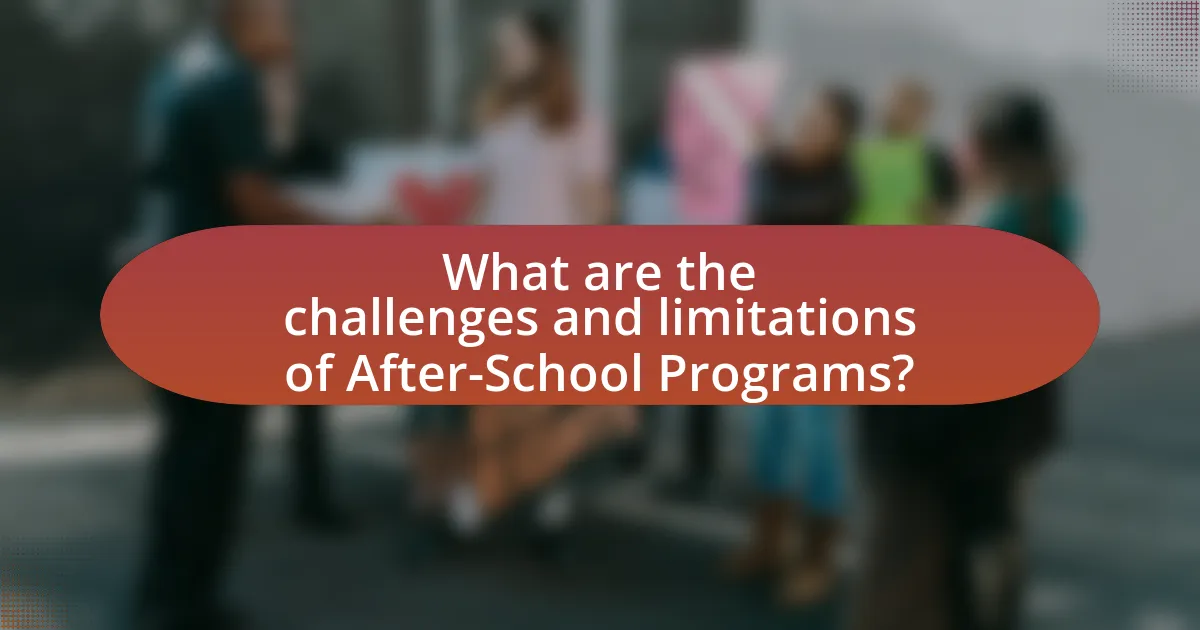
What are the challenges and limitations of After-School Programs?
After-school programs face several challenges and limitations, including funding constraints, inconsistent attendance, and varying program quality. Funding limitations often restrict the resources available for staffing, materials, and facilities, which can hinder program effectiveness. Inconsistent attendance can disrupt the continuity of learning and limit the benefits for students, as regular participation is crucial for skill development. Additionally, the quality of after-school programs can vary significantly, with some lacking trained staff or structured curricula, leading to disparities in student outcomes. According to a report by the Afterschool Alliance, nearly 19 million children in the U.S. are left unsupervised after school, highlighting the need for more accessible and high-quality programs to address these challenges.
What funding issues do After-School Programs encounter?
After-school programs encounter significant funding issues primarily due to inconsistent financial support and reliance on grants. Many programs depend on government funding, which can fluctuate annually, leading to uncertainty in budgeting and program sustainability. For instance, a report from the Afterschool Alliance indicates that 80% of after-school programs report funding challenges, with many unable to secure long-term financial commitments. This instability often results in reduced program hours, limited staffing, and diminished resources, ultimately affecting the quality of services provided to students.
How does funding affect program availability and quality?
Funding directly influences both the availability and quality of after-school programs. Adequate funding allows for the hiring of qualified staff, the provision of diverse educational resources, and the implementation of engaging activities, which collectively enhance program quality. For instance, a study by the Afterschool Alliance found that programs with stable funding are more likely to offer a wider range of services and maintain higher staff-to-student ratios, leading to improved student outcomes. Conversely, insufficient funding can result in limited program offerings, reduced operational hours, and compromised staff quality, ultimately diminishing the effectiveness of these programs in supporting student learning.
What are the implications of budget cuts on After-School Programs?
Budget cuts on after-school programs lead to reduced funding, resulting in fewer resources, staff layoffs, and limited program offerings. Research indicates that such cuts can diminish student engagement and academic performance, as after-school programs are crucial for providing additional learning opportunities and support. For instance, a study by the Afterschool Alliance found that 80% of parents believe after-school programs help their children succeed academically, highlighting the negative impact of budget reductions on student outcomes.
How can After-School Programs improve their effectiveness?
After-school programs can improve their effectiveness by implementing structured curricula that align with academic standards and student needs. Research indicates that programs with a clear focus on educational outcomes, such as those incorporating STEM activities, can enhance student engagement and learning. For instance, a study by the Afterschool Alliance found that students participating in high-quality after-school programs showed a 20% improvement in math and reading scores compared to their peers not involved in such programs. Additionally, fostering partnerships with local schools and community organizations can provide resources and support, further enhancing program effectiveness.
What best practices can be implemented to enhance program quality?
To enhance program quality in after-school programs, implementing structured curricula that align with educational standards is essential. Research indicates that programs with a clear educational framework significantly improve student engagement and learning outcomes. For instance, a study by the Afterschool Alliance found that after-school programs with defined goals and structured activities led to a 20% increase in student academic performance. Additionally, regular assessment and feedback mechanisms can help in refining program effectiveness, ensuring that the needs of students are met consistently.
How can community partnerships strengthen After-School Programs?
Community partnerships can strengthen After-School Programs by providing additional resources, expertise, and support that enhance program offerings. These partnerships often involve local businesses, non-profits, and educational institutions, which can contribute funding, volunteers, and specialized knowledge. For instance, a study by the Afterschool Alliance found that programs with community partnerships reported improved student engagement and academic performance, as they could offer diverse activities such as STEM workshops, arts programs, and mentorship opportunities. This collaborative approach not only enriches the curriculum but also fosters a sense of community ownership and investment in the educational outcomes of students.
What practical tips can parents consider when choosing After-School Programs?
When choosing after-school programs, parents should prioritize programs that align with their child’s interests and educational goals. This ensures engagement and motivation, which are crucial for effective learning. Additionally, parents should evaluate the program’s curriculum to confirm it complements school learning and fosters skill development. Research indicates that structured after-school activities can improve academic performance and social skills, as highlighted in a study by the Afterschool Alliance, which found that 74% of students in after-school programs showed improved academic outcomes. Furthermore, parents should consider the qualifications of the staff, ensuring they are trained and experienced in working with children. Safety and location are also critical factors; programs should be easily accessible and provide a secure environment. Lastly, parents should seek feedback from other parents and review program ratings to make informed decisions.
